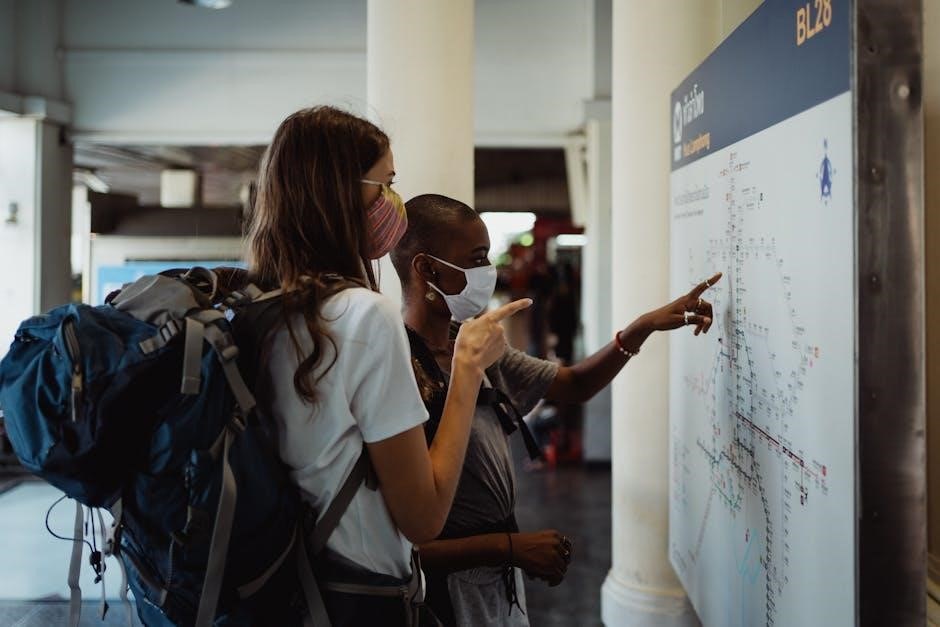Welcome to the SOS Safety Guide, your ultimate resource for understanding and utilizing distress signals effectively. Learn how to signal for help in emergencies using timeless methods like Morse code and modern technology.
1.1 Understanding the Importance of SOS Signals
SOS signals are a universal distress call, recognized globally as a plea for immediate help. Their simplicity and universality make them a crucial tool in emergencies, ensuring quick recognition and response. Whether in maritime, wilderness, or urban settings, SOS signals transcend language barriers, providing a standardized method for signaling distress. Their effectiveness lies in their ease of use and global understanding, making them a cornerstone of survival communication.
1.2 Brief History of SOS in Emergency Situations
The SOS signal was first introduced in 1905 by the German government as a universal distress call. Initially used in maritime emergencies, it gained global recognition for its simplicity and effectiveness. The first recorded American use of SOS was in 1909 by Theodore Haubner, calling for help from the SS Arapahoe. Over time, SOS expanded beyond maritime use, becoming a standard signal in various emergency situations, including wilderness and urban environments, due to its ease of use and universal recognition.

Classic SOS Morse Code
The classic SOS Morse code is a universal distress signal, represented by three dots, three dashes, and three dots, easily transmitted via sound, light, or tapping.
2.1 How to Spell SOS Using Morse Code
The SOS signal in Morse code is represented by three dots (S), three dashes (O), and three dots (S), creating the sequence …—…. This pattern is easy to remember and can be transmitted using sound, light, or tapping. Each dot is one unit, and each dash is three units, with spaces between letters. This universal distress signal is simple yet effective for emergency communication. Its repetitive structure ensures it stands out, making it a reliable method for signaling help in critical situations.
2.2 Expanding Morse Code: Spelling HELP and FOOD
Beyond SOS, Morse code can also be used to spell other essential words like HELP and FOOD. The word HELP translates to …. . .-.. .–. in Morse code, while FOOD is represented as ..-. — -… These sequences are crucial for conveying specific needs during emergencies, such as requesting assistance or indicating hunger. Understanding these codes enhances communication in survival situations, ensuring clearer and more precise signaling for help or resources.
Urban Safety and Distress Signals
Urban environments require tailored distress signals due to their crowded nature. Integrating modern technology, such as personal safety apps, enhances emergency communication in city settings effectively.
3.1 Using SOS in Urban Environments
In urban settings, SOS signals adapt to the surroundings. Honking vehicle horns three times or flashing headlights can alert others. Personal safety apps enable quick distress calls, while visible markers like red cloths on cars signal for help. Urban environments also benefit from community awareness and legal measures, ensuring timely assistance. Combining traditional methods with modern technology enhances safety in bustling city environments, making SOS a versatile tool for urban distress situations.
3.2 Modern Tech Integration: Personal Safety Apps
Modern technology has revolutionized SOS signaling through personal safety apps, enabling instant distress alerts. Features like emergency contact notifications, location sharing, and automatic alerts enhance urban safety. Apps like Google Pixel’s Safety Check and iPhone’s Emergency SOS allow users to quickly trigger alarms or send alerts to contacts. These tools integrate seamlessly with urban life, providing a digital solution to traditional SOS methods and ensuring help is just a tap away, even in unfamiliar environments.
Wilderness Survival and SOS
In wilderness survival, signaling distress is crucial. Hunters can fire three shots, while stranded drivers can honk three times and flash headlights. Using a red cloth as a marker is also effective. These methods align with SOS principles, ensuring visibility and auditory alerts in remote areas. Remember, clear signaling increases the chances of rescue.
4.1 Signaling for Help in Remote Areas
In remote areas, signaling for help requires creativity and visibility. Creating smoke during daylight or using reflective objects like mirrors can attract attention. At night, fires or flashlights can be used to signal distress. The international SOS pattern (three short, three long, three short signals) can be replicated with sounds, lights, or even ground markings. Consistency and repetition are key to ensuring your signal is recognized by rescuers or passersby. Stay visible and persistent to increase your chances of being noticed.
4.2 Using Fire and Light Signals for Distress
Fire and light signals are effective tools for signaling distress in remote areas. Building a large fire or creating a series of small fires in a visible pattern can attract attention. At night, flashing a light three times in succession, followed by a pause, and repeating this pattern mimics the SOS Morse code. Using reflective surfaces like mirrors or shiny objects to direct sunlight toward potential rescuers during the day can also signal for help effectively. Consistency in signaling increases the likelihood of being spotted.

Vehicle Emergency Signals
Vehicles offer unique ways to signal distress. Honking three short bursts and flashing headlights can alert others to your situation. Using visual markers like red cloth adds visibility.
5.1 Honking and Headlight Flashing Patterns
Honking three short bursts on your vehicle’s horn and flashing headlights three times is a universally recognized distress signal. This pattern grabs attention quickly and indicates urgency. Ensure your vehicle is visible by turning on hazard lights. In remote areas, repeat the sequence periodically to maintain visibility. This method is simple yet effective for signaling help in emergencies, especially when other tools like phones are unavailable. Always prioritize safety and visibility when using these signals.
5.2 Using Visual Markers like Red Cloth
Using visual markers such as a red cloth is an effective way to signal distress. Attach the cloth to your vehicle’s antenna or hang it from a window to increase visibility. Bright colors like red stand out in most environments, making it easier for rescuers to spot you. This method is particularly useful in stranded or broken-down situations where other signaling tools may not be available. Ensure the marker is securely fastened and clearly visible to maximize the chances of being noticed. This simple technique can significantly enhance your visibility and speed up rescue efforts.

Emergency Preparedness
Emergency preparedness is crucial for survival. Keep an emergency kit with essentials like food, water, and a first-aid kit. Learn to signal distress in various environments and stay informed about safety apps. Regularly check your supplies to ensure readiness.
6.1 Essential Items for an Emergency Kit
Your emergency kit should include water (at least 3 days’ supply), non-perishable food, a first-aid kit, flashlight, extra batteries, and a multi-tool or Swiss Army knife.
Add a whistle to signal for help, warm clothing, and a tarp for shelter. Include important documents like ID and insurance cards.
A portable phone charger and cash are also vital. Ensure all items are easy to carry and accessible. Regularly update supplies to maintain freshness and relevance.
6.2 How to Signal Distress in Different Environments
Adapt your distress signaling based on surroundings. In urban areas, use personal safety apps or three short horn honks and headlight flashes.
In wilderness, employ SOS Morse code (three short, three long, three short signals) with sounds, lights, or fires.
For vehicles, attach a red cloth to antennae or windows and use headlight patterns.
Ensure signals are consistent and visible to maximize rescue chances.
Legal and Protective Measures
Understanding legal and protective measures is crucial for ensuring safety. This section covers reporting dangers to authorities and utilizing modern device safety features effectively.
7.1 Reporting Danger to Local Authorities
Reporting danger to local authorities is a critical step in ensuring safety and protection. Timely reporting allows authorities to respond swiftly and effectively. Whether in person, via phone, or online platforms, it is essential to provide clear and accurate information. Modern tools like Safety Check features on devices can also assist in alerting authorities and sharing emergency details. Always prioritize legal and protective measures to safeguard yourself and others in distress situations.
7.2 Understanding Safety Check Features on Devices
Safety Check features on devices, like those found on iPhones and Pixel phones, are designed to enhance personal security. These tools allow users to quickly stop sharing locations, revoke app access, and review permissions. In emergencies, Safety Check can automatically alert authorities and trusted contacts. Such features empower individuals to manage their digital security seamlessly, ensuring privacy and protection during critical moments.

Real-Life Rescue Stories
Discover inspiring tales of survival, where SOS signals and modern tech saved lives. From maritime rescues to wilderness emergencies, these stories highlight the power of distress signaling.
8.1 Case Studies of Successful SOS Rescues
One notable case involves the steamship SS Arapahoe, which sent the first recorded American SOS in 1909, saving its crew from a life-threatening storm. Another example is a group of hunters who signaled distress with three gunshots, leading to their rescue in a remote wilderness. These real-life stories demonstrate the effectiveness of SOS signals, whether through Morse code, sound, or visual markers, in critical emergency situations, emphasizing their enduring relevance in saving lives.
8.2 Lessons Learned from Emergency Situations
Emergencies highlight the importance of preparedness and clear communication. Consistent signaling, like three short bursts or visual markers, increases chances of detection. Modern tools, such as personal safety apps, enhance traditional methods. Community awareness and quick reporting to authorities are critical. These lessons underscore the need for a combination of timeless techniques and technological integration to ensure effective distress signaling and timely rescue in crisis situations.
Mastering SOS signaling ensures preparedness in emergencies. Combine traditional methods with modern tools for effective distress calls. Stay informed, remain vigilant, and always be ready to act swiftly.
9.1 Staying Prepared and Aware
Preparedness is key to survival in emergencies. Always carry an emergency kit with essentials like water, food, and a first-aid kit. Stay informed about potential risks in your environment, whether urban or wilderness. Familiarize yourself with local laws and emergency services. Utilize technology, such as personal safety apps, to enhance your security. Awareness of surroundings and quick decision-making can save lives. Stay vigilant and proactive in safeguarding yourself and others.
9.2 Final Tips for Effective SOS Signaling
Always ensure clarity and consistency when signaling for help. Use universally recognized methods like the SOS Morse code or three short signals for sound or light. Stay visible by using reflective materials or smoke during daylight. Integrate technology, such as emergency apps, to send distress alerts instantly. Report your situation to authorities promptly and remain calm to maximize rescue chances. Preparing ahead and staying informed will significantly enhance your ability to signal effectively in critical situations.
